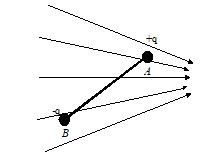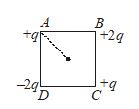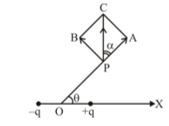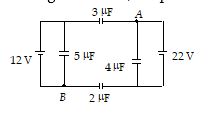Q.1
Two electrons are separated by a distance of 1 Å. The coulomb force between them is
(a) 2.3 × 10–8 N
(b) 4.6 × 10–8 N
(c) 1.5 × 10–8 N
(d) None of these.
Ans. (a)
Q.2
Find the force at point C. Assume four charges q each are placed at the vertices of a square of side ‘a’
(a) \displaystyle n=\frac{{2h{{u}^{2}}}}{{g{{b}^{2}}}} towards CA
(b) \displaystyle n=\frac{{2h{{u}^{2}}}}{{gb}}v towards CA
(c) \displaystyle n=\frac{{h{{u}^{2}}}}{{g{{b}^{2}}}}. towards AC
(d) \displaystyle {{\tan }^{{1}}}\left( {\frac{1}{5}} \right) towards AC.
Ans. (c)
Q.3
A positive point charge Q is brought near an isolated metal cube
(a) The cube becomes negatively charged
(b) The cube becomes positively charged
(c) The interior becomes positively charged and the surface becomes negatively charged
(d) The interior remains charge free and the surface gets non-uniform charge distribution.
Ans. (d)
Q.4
A given charge is situated at a certain distance from a short electric dipole in the end on a position, experiences a force F. If the distance of the charge is doubled, the force acting on the charge will be
(a) F/8 (b) F/4 (c) F/2 (d) 2F.
Ans. (a)
Q.5
An electric line of force in x-y plane is given by equation x2 + y2 + = 1. A particle with unit positive charge, initially at rest at the point x = 1, y = 0 in the x-y plane
(a) Will not move at all
(b) Will move along the straight line
(c) Will move along the circular line of force
(d) Information is insufficient to draw any conclusion.
Ans. (b)
Q.6
A metallic particle having no net charge is placed near a finite metal plate carrying a positive charge. The particle will:
(a) Be attached towards plate
(b) Be repelled by plate
(c) Experience zero force
(d) Experience force parallel to plate
Ans. (a)
Q.7
An electron initially at rest falls a distance of 1.5 cm in a uniform electric field of magnitude 2 ´ 104 N/C. The time taken by electron to fall this distance is:
(a) 1.3 ´ 102 s (b) 2.1 ´ 10–12 s (c) 1.6 ´ 10–10 s (d) 2.9 ´ 10–9 s
Ans. (d)
Q.8
A charge Q is placed at each of the opposite corners of a square. A charge q is placed at each of the other two corners. If the net electrical force on Q is zero, then Q/q equals:
(a) [/katex] \displaystyle \sqrt{{\frac{g}{{8h}}}}[/katex]
(b) -1
(c) 1
(d) [/katex] \displaystyle \sqrt{{\frac{g}{{4h}}}}[/katex]
Ans. (a)
Q.9
Two balls carrying charges +8 mC and -5 mC attracts each other with a force F. If a charge -3 mC is added to both, the forces between the balls will be:
(a) 3F (b) F (c) 2F (d) 0
Ans. (b)
Q.10
If the distance between the charges is doubled and magnitude of each charge is halved, then the force of attraction or repulsion will be:
(a) 16 times (b) same as before (c) 1/16 times (d) 4 times
Ans (c)
Q.11
Two equal –ve charges are fixed at the points (0, a) and (0 –a) on the y-axis. A positive charge Q is released from rest at the point (2a, 0) on the x-axis. The charge will
(a) Execute SHM about the origin
(b) Move to the origin and remain at rest
(c) Move to infinity
(d) Execute oscillatory but not SHM
Ans. (d)
Q.12
A charge is placed at the midpoint of the line joining two equal charges . The system of three charges will be in equilibrium when has the value
(a) [/katex] \displaystyle \frac{\alpha }{{2\beta }}[/katex]
(b) [/katex] \displaystyle \sqrt{{\frac{\alpha }{{2\beta }}}}.[/katex]
(c) [/katex] \displaystyle h\sqrt{{\frac{g}{{2x}}}}[/katex]
(d) [/katex] \displaystyle x\sqrt{{\frac{g}{{2h}}}}[/katex]
Ans. (c)
Q.13
An electric charge q exerts force F on another similar charge q separated by a distance r. Now a charge of 2q is placed at the midpoint of the previous charges. The new force between previous two charges is:
(a) F (b) 2 F (c) F/2 (d) 4 F
Ans. (a)
Q.14
An electric line of force is leaving a charged spherical conductor. The angle between the electric line of force and surface of conductor is:
(a) 0° (b) p/2 (c) p (d) p/4
Ans. (b)
Q.15
If a glass rod is rubbed with silk it acquires a positive charge because
(a) Protons are added to it
(b) Protons are removed from it
(c) Electrons are added to it
(d) Electrons are removed from it
Ans. (d)
Q.16
A 3 mC point charge is kept in an external uniform electric field of 1.6 ´ 104 NC–1. At what distance from the point charge the net electric field would be zero?
(a) 3 m (b) 1.3 m (c) 2 m (d) 4.6 m
Ans. (b)
Q.17
A point Q lies on the perpendicular bisector of an electrical dipole of dipole moment p. If the distance of Q from the dipole is r (much larger than the size of the dipole). Then, electric field at Q is proportional to
(a) p2 and r3 (b) p4 and r2 (c) p and r2 (d) p and r–3.
Ans. (d)
Q.18
Two connected charges of +q and -q respectively are at a fixed distance AB apart in a non uniform electric field whose lines of force are shown in the figure
The resultant effect on the two charges is
(a) A torque in the plane of the paper and no resultant force
(b) A resultant force in the plane of the paper and no torque
(c) A torque normal to the plane of the paper and no resultant force
(d) A torque normal to the plane of the paper and a resultant force in the plane of the paper
Ans. (d)

Q.19
Four charges are arranged at the corners of square ABCD as shown in figure. Force on charge kept at the center is
(a) Perpendicular to side AB
(b) Along diagonal AC
(c) Along diagonal BD
(d) Zero.
Ans. (c)

Q.20
The linear charge density on upper half of a segment of ring is l and at lower half it is -l. The direction of electric field at centre O of ring is:
(a) along OA
(b) along OB
(c) along OC
(d) along OD
Ans. (c)

Q.21
Two point charges are placed as shown in the figure. The medium between them is of two types. The electric force acting between them is:
(a) 1.75 ´ 10–3 N
(b) 1.73 ´ 10–4 N
(c) 0.18 ´ 10–4 N
(d) 0.18 ´ 10–3 N
Ans. (b)

Q.22
An uncharged metal sphere is placed between the two equal and oppositely charged metal plates. The nature of lines of force will be:
Ans. (d)

Q.23
An electric dipole of moment is placed at the origin at the along the x-axis. The electric field at a point P. Whose position vector makes an angle q with the x-axis, will make an angle…. With the x-axis: (where tan a = ½ tan q)
(a) a (b) q
(c) q + a (d) 2q + a
Ans. (c)

Q.24
The electric field due to a uniformly charged solid insulating sphere of radius R as a function of the distance from its centre is represented graphically by:
Ans. (b)

Q.25
In the given circuit, the potential difference between A and B is
(a) 0 (b) 10 V
(c) 14 V (d) 16 V
Ans. (c)

